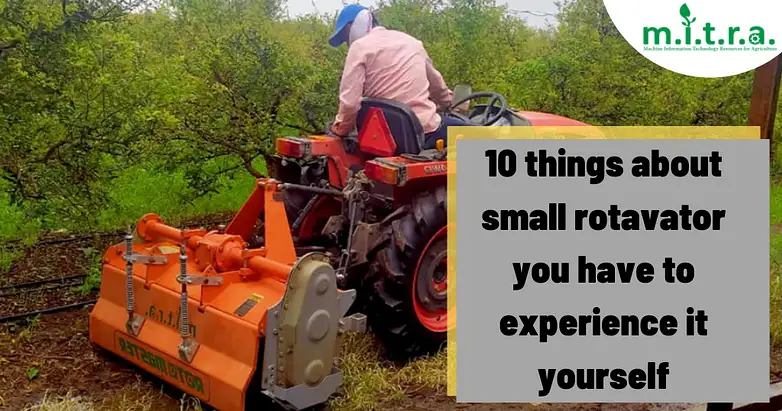Farmers must use various cultured agricultural equipment to make excellent soil surfaces to promote good crop yield. According to the task, farmers must undertake several culturing operations in both essential and optional advances, using various technologies and agricultural equipment such as an agriculture sprayer machine. Soil arrangement is a long process that requires a great deal of effort and time. The farmer should use the correct farm implement to increase the efficacy and efficiency of agricultural production.
What is Rotavator?
A small rotavator, also known as a rotating turner, is an excellent agrarian tool for arranging the soil and preparing a seedbed for sowing. The rotavators use a series of sharp blades to twist and slice through the earth, resulting in a smooth surface. It increases seepage, increases supplementation, and reduces weeds from the soil, making it suitable for crop planting.
It is used as a tractor supplement powered by the tractor’s PTO. Rotavators are a culturing tool used for soil preparation that works similarly to cultivators and turners. While all rotavators operate simultaneously, new versions are increasingly being developed to provide varying capabilities depending on the job.
Rotavator’s Versatile Use–
A rotavator is a versatile agricultural implement that allows a farmer to do various necessary and optional plowing tasks on their farmland. A farmer can increase his return and benefit his farming business by using a rotavator. A range of tractor-sprayer pump and weeding equipment is available. The spray tanks placed on the mini tractor sprayer are appropriate for complex and essential tasks and provide a high output. Learn the best tips for choosing the best rotavator for your tractor in this article. Here are the 10things you need to know about a small rotavator:
1. Breaking up lumps in the soil and evening it out.
2. Seedbed preparation.
3. Used as versatile equipment for both required and optional culturing tasks.
4. Reduces fuel use and saves time.
5. It eliminates weeds and improves soil crushing.
6. Use a rotavator to completely clear crop stubble.
7. Various models are available on the market to carry out varied tasks.
8. The casing may be adjusted to get the desired depth.
9. Using a Tractor rotavator, a farmer can prepare more extensive grounds in a concise amount of time.
10. Remove and circulate air through the soil up to a depth of 10 to 15 cm.
Farmers can rely on this agricultural equipment to build up the land and cover larger areas in a minor period with excellent proficiency.
The Advantages of Using a Rotavator
The rotavator allows farmers to prepare the land with the least effort and human labor. It guarantees that the seedbed is perfectly prepared before sowing.
It breaks up the soil to ensure that the most nutrients are delivered to the new harvests. Better soil structure improves the chances of a high harvest return, resulting in more noticeable benefits.
The rotavator has many bents and spinning cutting blades that slice through the dirt, leaving it hunk-free. The operator may alter the speed of the machine thanks to an integrated gearbox while the edges continue to rotate at the same level.
The speed also varies depending on the model you select. Another advantage of acquiring a rotavator is that it is easy to use and consumes less fuel than other farm devices of equivalent capacity.
One of the most critical aspects of this agricultural equipment is that its great motors and massive sharp edges can operate much larger land areas in a concise amount of time. Cultivating is more productive using rotavators.
Points to Consider Before Buying a Rotavator –
- Rotavator Size
- Rotavator Price
- Rotavator Blades
- Sorts of Blades
- Rotavator Features
Rotavator Size –
Various types of rotavators are now available on the market. These are designed in a variety of sizes and forms for diverse applications.
The smaller versions of a turning turner, such as a mini rotavator, are explicitly designed for use in nurseries and small vegetable nurseries.
While large tractor rotavators are practical to use and operate across vast land areas such as yield and grain fields, Rotavators used in cultivation are typically 3 to 7 feet in length. Rotavators of this type are used in a wide range of agricultural operations.
How to Choose the Right Rotavator for Your Tractor-
When choosing a rotavator for your tractor, keep in mind certain vital factors, such as the horsepower of your tractor, the area of the field you’re cultivating, and the type of soil you’re working with.
The size of the area you operate in is crucial in determining the size of the rotavators you need. Typically, commercial farmers should use rotavators with large rotators to make working compacted soils easier.
A rotavator necessary for unappealing land that has never been planted should be sufficient for compacted soil. Remember to compare the various models before purchasing a rotavator.
Rotavator Cost in India –
Their size and capacity usually determine the cost of agricultural rotavators. A multi-speed rotavator can cost up to a lakh per unit.

